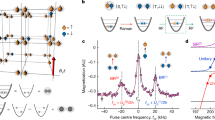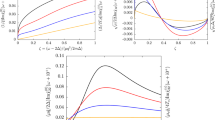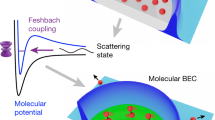Abstract
Spontaneous symmetry breaking is a central paradigm of elementary particle physics1, magnetism2, superfluidity3 and superconductivity4. According to Goldstone’s theorem, phase transitions that break continuous symmetries lead to the existence of gapless excitations in the long-wavelength limit5. These Goldstone modes can become the dominant low-energy excitation, showing that symmetry breaking has a profound impact on the physical properties of matter. Here, we present a comprehensive study of the elementary excitations in a homogeneous strongly interacting Fermi gas through the crossover from a Bardeen–Cooper–Schrieffer (BCS) superfluid to a Bose–Einstein condensate (BEC) of molecules using two-photon Bragg spectroscopy. The spectra exhibit a discrete Goldstone mode, associated with the broken-symmetry superfluid phase, as well as pair-breaking single-particle excitations. Our techniques yield a direct determination of the superfluid pairing gap and speed of sound in close agreement with strong-coupling theories.
This is a preview of subscription content, access via your institution
Access options
Access Nature and 54 other Nature Portfolio journals
Get Nature+, our best-value online-access subscription
$29.99 / 30 days
cancel any time
Subscribe to this journal
Receive 12 print issues and online access
$259.00 per year
only $21.58 per issue
Buy this article
- Purchase on SpringerLink
- Instant access to full article PDF
Prices may be subject to local taxes which are calculated during checkout




Similar content being viewed by others
References
Nambu, Y. & Jona-Lasino, G. Dynamical model of elementary particles based on an analogy with superconductivity. Phys. Rev. 122, 345–358 (1961).
Ashcroft, N. W. & Mermin, N. D. Solid State Physics (Holt, Rinehart & Winston, 1976).
Griffin, A. Excitations in a Bose Condensed Liquid (Cambridge Univ. Press, 1993).
Anderson, P. W. Random-phase approximation in the theory of superconductivity. Phys. Rev. 112, 1900–1916 (1958).
Goldstone, J. Field theories with superconductor solutions. Nuovo Cimento. 19, 154–164 (1961).
Pekker, D. & Varma, C. M. Amplitude/Higgs modes in condensed matter physics. Annu. Rev. Condens. Matter Phys. 6, 269–297 (2015).
Bogoliubov, N. N. On the theory of superfluidity. J. Phys. USSR 11, 23–32 (1947).
Zwerger, W. (ed.) BCS–BEC Crossover and the Unitary Fermi Gas (Lecture Notes in Physics, Springer, 2012).
Joseph, J. et al. Measurement of sound velocity in a Fermi gas near a Feshbach resonance. Phys. Rev. Lett. 98, 170401 (2007).
Sidorenkov, L. A. et al. Second sound and the superfluid fraction in a Fermi gas with resonant interactions. Nature 498, 78–81 (2013).
Weimer, W. et al. Critical velocity in the BEC-BCS crossover. Phys. Rev. Lett. 114, 095301 (2015).
Haussmann, R., Rantner, W., Cerrito, S. & Zwerger, W. Thermodynamics of the BCS–BEC crossover. Phys. Rev. A 75, 023610 (2007).
Stenger, J. et al. Bragg spectroscopy of a Bose–Einstein condensate. Phys. Rev. Lett. 82, 4569–4573 (1999).
Steinhauer, J., Ozeri, R., Katz, N. & Davidson, N. Excitation spectrum of a Bose–Einstein condensate. Phys. Rev. Lett. 88, 120407 (2002).
Veeravalli, G., Kuhnle, E., Dyke, P. & Vale, C. J. Bragg spectroscopy of a strongly interacting Fermi gas. Phys. Rev. Lett. 101, 250403 (2008).
Rueff, J.-P. & Shukla, A. Inelastic X-ray scattering by electronic excitations under high pressure. Rev. Mod. Phys. 82, 847–896 (2010).
Brunello, A., Dalfovo, F., Pitaevskii, L., Stringari, S. & Zambelli, F. Momentum transferred to a trapped Bose–Einstein condensate by stimulated light scattering. Phys. Rev. A 64, 063614 (2001).
Beliaev, S. T. Energy spectrum of a non-ideal Bose gas. Sov. Phys. JETP 2, 299–307 (1958).
Schunck, C. H., Shin, Y., Schirotzek, A. & Ketterle, W. Determination of the fermion pair size in a resonantly interacting superfluid. Nature 454, 739–743 (2008).
Marini, M., Pistolesi, F. & Strinati, G. C. Evolution from BCS superconductivity to Bose condensation: analytic results for the crossover in three dimensions. Eur. Phys. J. B 1, 151–159 (1998).
Combescot, R., Kagan, M. Yu. & Stringari, S. Collective mode of homogeneous superfluid Fermi gases in the BEC–BCS crossover. Phys. Rev. A 74, 042717 (2006).
Hoinka, S., Lingham, M., Delehaye, M. & Vale, C. J. Dynamic spin response of a strongly interacting Fermi gas. Phys. Rev. Lett. 109, 050403 (2012).
Ku, M. J. H., Sommer, A. T., Cheuk, L. W. & Zwierlein, M. W. Revealing the superfluid lambda transition in the universal thermodynamics of a unitary Fermi gas. Science 335, 563–567 (2012).
Stewart, J. T., Gaebler, J. P. & Jin, D. S. Using photoemission spectroscopy to probe a strongly interacting Fermi gas. Nature 454, 744–747 (2008).
Schirotzek, A., Shin, Y., Schunck, C. H. & Ketterle, W. Determination of the superfluid gap in atomic Fermi gases by quasiparticle spectroscopy. Phys. Rev. Lett. 101, 140403 (2008).
Pieri, P., Pisani, L. & Strinati, G. C. BCS–BEC crossover at finite temperature in the broken-symmetry phase. Phys. Rev. B 70, 094508 (2004).
Carlson, J. & Reddy, S. Superfluid pairing gap in strong coupling. Phys. Rev. Lett. 100, 150403 (2008).
Diener, R. B., Sensarma, R. & Randeria, M. Quantum fluctuations in the superfluid state of the BCS–BEC crossover. Phys. Rev. A 77, 023626 (2008).
Gubler, P., Yamamoto, N., Hatsuda, T. & Nishida, Y. Single-particle spectral density of the unitary Fermi gas: novel approach based on the operator product expansion, sum rules and the maximum entropy method. Ann. Phys. 356, 467–497 (2015).
Tajima, H. et al. Strong-coupling corrections to ground-state properties of a superfluid Fermi gas. Phys. Rev. A 95, 043625 (2017).
Kurkjian, H., Castin, Y. & Sinatra, A. Concavity of the collective excitation branch of a Fermi gas in the BEC–BCS crossover. Phys. Rev. A 93, 013623 (2016).
Manini, N. & Salasnich, L. Bulk and collective properties of a dilute Fermi gas in the BCS–BEC crossover. Phys. Rev. A 71, 033625 (2005).
Acknowledgements
We thank W. Zwerger, G. Strinati, L. Salasnich and Y. Ohashi for sharing their data and comments on the manuscript and P. Hannaford for fruitful discussions. This work was supported by ARC Discovery Project DP130101807. G.M.B. wishes to acknowledge the support of the Villum Foundation via Grant No. VKR023163 and ARC Discovery Project DP160102739.
Author information
Authors and Affiliations
Contributions
S.H., P.D., M.G.L. and C.J.V. conducted the experimental work and data analysis. J.J.K. and G.M.B. performed the theoretical calculations. All authors contributed to the manuscript preparation.
Corresponding author
Ethics declarations
Competing interests
The authors declare no competing financial interests.
Supplementary information
Supplementary information
Supplementary information (PDF 372 kb)
Rights and permissions
About this article
Cite this article
Hoinka, S., Dyke, P., Lingham, M. et al. Goldstone mode and pair-breaking excitations in atomic Fermi superfluids. Nature Phys 13, 943–946 (2017). https://doi.org/10.1038/nphys4187
Received:
Accepted:
Published:
Issue Date:
DOI: https://doi.org/10.1038/nphys4187
This article is cited by
-
Higher-order topology for collective motions
Complex & Intelligent Systems (2025)
-
Stability and sensitivity of interacting fermionic superfluids to quenched disorder
Nature Communications (2024)
-
Dominant andreev reflection through nonlinear radio-frequency transport
Communications Physics (2023)
-
Spectroscopic probes of quantum gases
Nature Physics (2021)
-
Linear response of a superfluid Fermi gas inside its pair-breaking continuum
Scientific Reports (2020)



